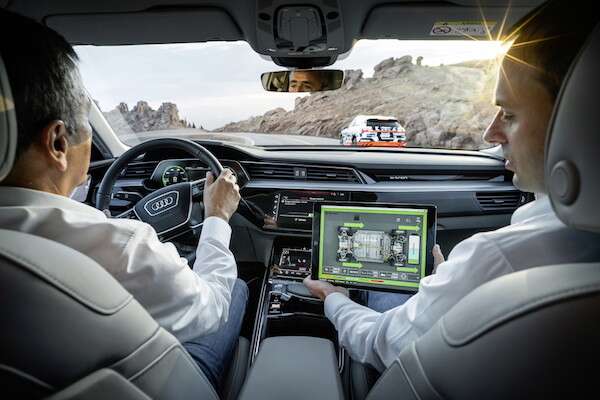Audi announced Wednesday that it deployed test mules of its upcoming electric e-Tron crossover to the 14,115-foot summit of Pikes Peak in Colorado Springs, Colorado for a rigorous test of the vehicle’s regenerative braking system, which converts forward momentum into electricity to feed back into the car’s battery.
On the descent from the mountaintop to base, which spans 6,234 feet of altitude and covers 19 miles (31 kilometers) of tarmac, the e-Tron’s 300 newton-meter (221 pound-feet), 220-kilowatt regenerative braking system absorbed enough energy to propel the vehicle “approximately the same distance.” In an email to The Drive, an Audi spokesperson revealed this to be in the range of 10 kilowatt-hours, suggesting the e-Tron can travel about three kilometers for every kilowatt-hour of energy in its battery.
Audi claims the system to be more efficient than regenerative braking systems found in any existing mass-produced electric vehicle, and that it provides up to 30 percent of the energy used to reach the vehicle’s maximum range of 249 miles (400 kilometers). With these numbers, we can estimate the e-Tron’s battery capacity to be a minimum of 90 kWh in capacity.
Regenerative braking in the e-Tron is managed in three modes, selected with the vehicle’s shift paddles. Automated regeneration can be deactivated on the lowest setting, engaging only when called on by the driver’s foot. Typical braking with under 0.3 G-forces of deceleration will solely use regenerative braking to stop the vehicle, but if the car’s accelerometer detects heavier braking, it will engage an electro-hydraulically actuated friction brake. In english, those are traditional disc brakes, but the car’s computer has a say in when they’re used. Audi advertises the transition between these systems as seamless.
On higher settings, heavy regenerative braking will occur when the driver lifts off the accelerator, and when cooperating with the e-Tron’s optional adaptive cruise control, the vehicle will slow and accelerate on its own with surrounding traffic.
Potent regenerative brakes are necessary for the e-Tron to recover the energy its 265-kilowatt (355 horsepower) and 561 newton-meter (414 pound-feet) twin electric motors (more in its eight seconds of “boost mode”) use to accelerate from a standstill to 60 in under six seconds. Its limited top speed of 124 mph (200 kph) can be sustained for almost a minute before its motors revert to more efficient modes.
Audi confirmed to The Drive that it has no intentions to enter the e-Tron in the Pikes Peak International Hill Climb, where electric vehicles this year established themselves as a competitive force.
Source: Read Full Article



